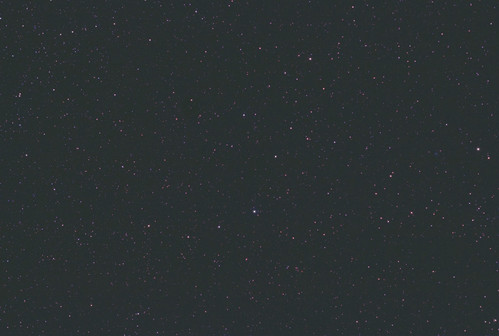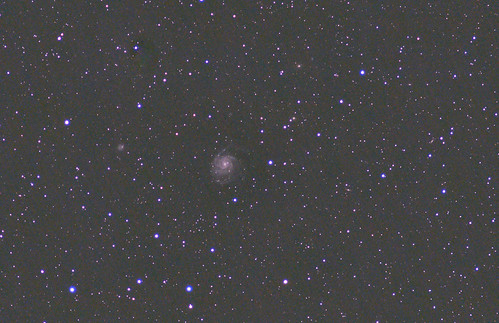Observing Log for Mike Durkin
5/26-27/17 about 10:30PM-2:00AM
Locust Valley, NY
Transparency: 9/10 Seeing: 4/5
Temperature: 55-65 degrees
Equipment: Hutech modified Canon T3i and Sky-Watcher Star Adventurer
First test of a couple of the toys I got from this year's NEAF.
First off, the DSLR Bahtinov masks. I really need to get the UV filters to mount these in, but
by crudely using tape, the focusing masks worked pretty well. One note on the mask for the 50mm
lens, the diffraction patter didn't look like the normal 6 spikes. I only saw 4 spikes in a cross
pattern.
I also used the new Star Adventurer tracking mount. My initial thoughts:
Polar alignment seems to be easier compared to the Astrotrac, although the directions to do so
were not easy to understand initially.
I have to get a couple of extra tripod mount thread adapters as a backup and also to use the other
platform which I think will let me do slow motion controls easier, at least in one axis.
First target was the constellation of Corona Borealis. The mount seemed to track very well with
the polar alignment and for short exposures (15sec) with a 50mm lens.
As a bonus I managed to pick up comet Johnson C/2015 V2 by dumb luck.
Then I tried the area around M101 with full zoom on the 75-300mm lens. Unfortunately the zoom must have slipped before I put the tape on to fix it in place, the actual focal length ended up being about 240mm. So in this case the tracking was OK to good for most of the images, but about 20-25% of them had significant trailing. This is about the limit of what I have been told about this mount, which is about 200mm. The exposures were 45 secounds each, so maybe shortening that to 30 seconds would have reduced the perentage of bad frames? A first look of the images I can see the core of M101 and hints of the arms, plus a couple of surrounding background galaxies. Hope the final image comes out at least decent.
5/17/2017 about 9:30PM-10:30PM
Willemstad, Curaçao
Transparency: 7/10, Seeing 3/5
Temperature: about 75-85 degrees
Equipment: 10x50 binoculars
Still on vacation.
Since it was a little earlier than my last session, I tried to see the nebular around η Carina.
I eventually found the region for the nebula, but it wasn't immediately apparent. It was a rich star
field and noted star clusters NGC3292 (Gem Cluster) and I believe NGC3532. After repeatedly scanning
the area and trying to use averted vision, I do think I detected some of the nebula around η Carina,
and possible a dark lane trailing away from it. It is a little hard to tell where I might be seeing
nebula versus background stars.
Also went back to Centaurus A (NGC 5128). I am slightly more confident that I may have seen it, but
still not certain. I also think that light pollutin ay be worse that Long Island. Stars that were
magnitude 2-3 were visible, but not easily. However that could also be local sky conditions, which
seemed irregular during the evening with scattered clouds.
5/14-15/2017 about 11:00PM-1:00AM
Willemstad, Curaçao
Transparency: 6/10, Seeing 3/5
Temperature: about 80-90 degrees
Equipment: 10x50 binoculars
On vacation and brought binoculars with me. Wanted to try to see some things from a southern latitude
that I don't normally get to see from the NYC area. Light pollution roughly seemed to be about the same
as Long Island.
ω Cen: Globular cluster, a little faint in binoculars, but appears to be about 0.5-1.0 degrees in size. Unable to
resolve any individual stars, but with a steady mount, maybe that could be possible. Must look amazing
in a small scopo or larger.
α Cen: nothing special observed, but just wanted to note that this may be the first time I have ever
seen the closest star to the sun.
Southern Cross
Jewel box cluster (NGC 4755): small and compact.
M7 (Ptolmey's cluster): fiarly large and well scattered. probably best seen in binos or a small scope.
Star clusters NGC6231, Collinder 316 and Trumpler 24, all the same general region in Scorpius. Also tried
to see the nebula IC 4628, but was not able too.
Quick look at the 19 day old moon and saturn.
Tried to see Eta Carina nebula, but was not able to.
In the end I spend a good amount of time trying to see the galaxy Centaurus A (NGC 5128). After multiple
scans of the area and waiting for clearing between multiple cloud banks, I might have just picked up a faint
impression of it, but not enough to consider it a confirmed sighting.
<-- 2016 Jan Feb Mar Apr May Jun Jul Aug Sep Oct Nov Dec 2018 -->

